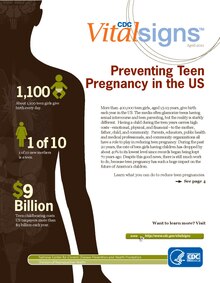| Teenage pregnancy | |
|---|---|
| Other names | Teen pregnancy, adolescent pregnancy |
 | |
| A US government poster on teen pregnancy. Over 1,100 teenagers, mostly aged 18 or 19,[1] give birth every day in the United States. | |
| Specialty | Obstetrics |
| Symptoms | Pregnancy under the age of 20[2] |
| Complications | [3] |
| Prevention | |
| Frequency | 23 million per year in the developed world, 2018.[3] |
| Deaths | Leading cause of death in 15 to 19 year old females, 2018.[3] |
Teenage pregnancy, also known as adolescent pregnancy, is pregnancy in a female under the age of 20.
Worldwide, pregnancy complications are the leading cause of death for women and girls 15 to 19 years old.[3] The definition of teenage pregnancy includes those who are legally considered adults in their country.[2] The World Health Organization defines adolescence as the period between the ages of 10 and 19 years.[5] Pregnancy can occur with sexual intercourse after the start of ovulation, which can happen before the first menstrual period (menarche).[6] In healthy, well-nourished girls, the first period usually takes place between the ages of 12 and 13.[7]
Pregnant teenagers face many of the same pregnancy-related issues as older women.[8][9] Teenagers are more likely to experience pregnancy complications or maternal death than women aged 20 or older. There are additional concerns for those under the age of 15 as they are less likely to be physically developed to sustain a healthy pregnancy or to give birth.[10] For girls aged 15–19, risks are associated more with socioeconomic factors than with the biological effects of age.[11] Risks of low birth weight, premature labor, anemia, and pre-eclampsia are not connected to biological age by the time a girl is 16, as they are not observed in births to older teens after controlling for other risk factors, such as access to high-quality prenatal care.[12][13]
Teenage pregnancies are related to social issues, including lower educational levels and poverty.[3] Teenage pregnancy in developed countries is usually outside of marriage and is often associated with a social stigma.[14] Teenage pregnancy in developing countries often occurs within marriage and approximately half are planned.[3] However, in these societies, early pregnancy may combine with malnutrition and poor health care to cause medical problems. When used in combination, educational interventions and access to birth control can reduce unintended teenage pregnancies.[4][15]
In 2023, globally, about 41 females per 1,000 gave birth between the ages of 15 and 19, compared with roughly 65 births per 1,000 in 2000.[16] From 2015 to 2021, an estimated 14 percent of adolescent girls and young women globally reported giving birth before age 18.[17] The adolescent birth rate is higher in lower- and middle-income countries (LMIC), compared to higher- income countries. In the developing world, approximately 2.5 million females aged 15 to 19 years old have children each year.[3] Another 3.9 million have abortions.[3] It is more common in rural than urban areas.[3]
In 2021, 13.3 million babies, or about 10 percent of the total worldwide, were born to mothers under 20 years old.[18]
- ^ Hamilton, Brady E.; Ventura, Stephanie J. (10 April 2012). "Birth Rates for U.S. Teenagers Reach Historic Lows for All Age and Ethnic Groups". NCHS Data Brief (89). Centers for Disease Control and Prevention: 1–8. PMID 22617115. Retrieved 18 April 2012.
- ^ a b Adolescent Pregnancy (PDF). World Health Organization. 2004. p. 5. ISBN 978-9241591454. Retrieved 28 July 2017.
- ^ a b c d e f g h i "Adolescent pregnancy". World Health Organization. 23 February 2018. Retrieved 2 November 2018.
- ^ a b Oringanje, Chioma; Meremikwu, Martin M; Eko, Hokehe; Esu, Ekpereonne; Meremikwu, Anne; Ehiri, John E (3 February 2016). "Interventions for preventing unintended pregnancies among adolescents". Cochrane Database of Systematic Reviews. 2016 (2): CD005215. doi:10.1002/14651858.cd005215.pub3. PMC 8730506. PMID 26839116.
- ^ "Adolescent health". World Health Organization. Retrieved 7 November 2022.
- ^ Hirsch, Larissa (September 2016). "Can a Girl Get Pregnant if She Has Never Had Her Period?". KidsHealth.
- ^ Marques, P.; Madeira, T.; Gama, A. (2022). "Menstrual cycle among adolescents: Girls' awareness and influence of age at menarche and overweight". Revista Paulista de Pediatria. 40: e2020494. doi:10.1590/1984-0462/2022/40/2020494. PMC 8734600. PMID 35019010.
- ^ Nolen, Stephanie (July 18, 2022). "What Pregnancy and Childbirth Do to the Bodies of Young Girls". The New York Times.
- ^ Jeha, D.; Usta, I.; Ghulmiyyah, L.; Nassar, A. (2015). "A review of the risks and consequences of adolescent pregnancy". Journal of Neonatal-Perinatal Medicine. 8 (1): 1–8. doi:10.3233/NPM-15814038. PMID 25766198.
- ^ Mayor S (2004). "Pregnancy and childbirth are leading causes of death in teenage girls in developing countries". BMJ. 328 (7449): 1152. doi:10.1136/bmj.328.7449.1152-a. PMC 411126. PMID 15142897.
- ^ Makinson C (1985). "The health consequences of teenage fertility". Family Planning Perspectives. 17 (3): 132–139. doi:10.2307/2135024. JSTOR 2135024. PMID 2431924.
- ^ Loto OM, Ezechi OC, Kalu BK, Loto A, Ezechi L, Ogunniyi SO (2004). "Poor obstetric performance of teenagers: Is it age- or quality of care-related?". Journal of Obstetrics & Gynaecology. 24 (4): 395–398. doi:10.1080/01443610410001685529. PMID 15203579. S2CID 43808921.
- ^ Raatikainen, Kaisa; Heiskanen, Nonna; Verkasalo, Pia K.; Heinonen, Seppo (1 April 2006). "Good outcome of teenage pregnancies in high-quality maternity care". European Journal of Public Health. 16 (2): 157–161. doi:10.1093/eurpub/cki158. ISSN 1464-360X. PMID 16141302.
- ^ "Young mothers face stigma and abuse, say charities". BBC News. 25 February 2014.
- ^ International technical guidance on sexuality education: An evidence-informed approach (PDF). Paris: UNESCO. 2018. p. 18. ISBN 978-92-3-100259-5.
- ^ "Adolescent pregnancy". www.who.int. Retrieved 13 September 2023.
- ^ "Early childbearing can have severe consequences for adolescent girls". UNICEF. December 2022.
- ^ United Nations. Department of Economic and Social Affairs. World Population Prospects 2022. Summary of Results (PDF). New York.